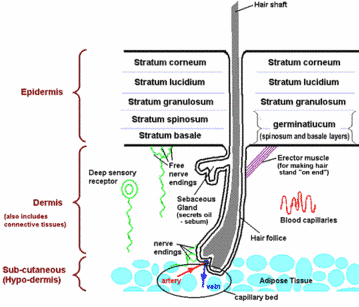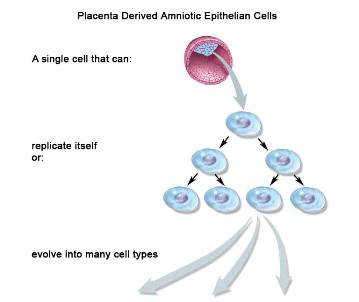Skin aging is a complex biological process that is a consequence of both intrinsic, genetically programmed aging that occurs with time, and extrinsic aging caused by environmental stressors such as:

Three of the cell types that are most important in the fight against external stressors and aging are macrophages, fibroblasts and keratinocytes.
Macrophages are white blood cells, more specifically phagocytes, acting in the non-specific defense as well as the specific defense system of vertebrate animals. Their role is to phagocytize (engulf and then digest) cellular debris (such as dead skin) and pathogens either as stationary or mobile cells.
A fibroblast is a cell that makes the structural fibers and ground substance of connective tissue. Fibroblasts make collagens, glycosaminoglycans, reticular and elastic fibers, and glycoproteins found in the extra cellular matrix (ECM) of the skin.
The keratinocyte is the major cell type of the epidermis, making up about 90% of epidermal cells. Keratinocytes originate in the basal layer from the division of keratinocyte stem cells. They are pushed up through the layers of the epidermis, undergoing gradual differentiation until they reach the stratum corneum where they form a layer of dead, flattened, highly keratinized cells called squamous cells. This layer forms an effective barrier to the entry of foreign matter and infectious agents into the body through the skin and minimizes moisture loss. In a normal and healthy system keratinocytes are shed and replaced continuously from the stratum corneum. The time of transit from basal layer to shedding is approximately one month.
The reason skins cells "stick together" is because of collagen. It is the "glue" that binds the cells. As our skin is externally damaged or ages our skin cells die and a healthy immune system "unglues" the dead cells from the collagen by an enzyme released from the macrophage, called collagenase. Then the phagocytes come in and "eat" the debris. This gives room for the new cells to grow. The next step in this process is when epidermal growth factors are secreted. These are proteins that act as signal messages that are sent out by the macrophages to fibroblasts. The fibroblast comes to the injured area where the new cell growth has been created and starts to produce collagen again.
Without this process, there is cross-linking of collagen, which creates wrinkles. There is also granulisation on and around dead or damaged tissue, all of which adds up to what we know as an appearance of aging. When the immune system, as found in the skin, is functioning properly, the dead and damaged tissue is removed, there is rapid healing, and the result is a smooth repaired area, with good tensile strength.
The key to our AlwaysYoung products' success is the healthy functioning of the macrophage, which is revitalized by stem cells derived from sheep placenta.
Another benefit of the stem cells is in the assistance they provide to the development of collagen producing cells.
Our Stem Cell Mask is unique in that it contains 4 types of pluropotent Stem Cells originated in placenta: Umbilical Vein Endothelial Cells (UVECs), Umbilical Cord Matrix Cells(UCMCs), Mesenchymal Stem Cells(MSCs) and Amniotic Epithelial Stem Cells(AESCs). These stem cells express surface makers normally present on embryonic stem and germ cells.

Based on immunohistochemical and genetic analysis, placental stem cells have the potential to differentiate into all three germ layers - endoderm (liver, pancreas), mesoderm (cardiomyocyte), and ectoderm (neural cells). These young cells imprint their vigor upon old, tired, and degenerating cells. This stimulates them to function with renewed efficiency, producing healthier, younger looking skin.
Term placenta following live birth is a useful and non-controversial source of stem cells for cell transplantation and regenerative medicine.
Placental Stem Cells (like Embryonic Stem Cells) are unique in that they are "pluripotent" - capable of differentiating into the different cells in the body - and hold great potential for treating damaged or diseased organs. In addition, these cells express the pluripotent stem cell specific transcription factors octamer-binding protein 4 (Oct-4), and the "immortality" gene Nanog. Until the discovery of the gene Nanog, scientists did not know how stem cells renew themselves or develop into a new kind of cell.
The gene Nanog found in mouse ESCs and some human equivalents appears to be the "master gene", coordinating other genes to allow stem cells to multiply limitlessly, while still retaining their ability to differentiate. It has been christened Nanog after the land in Celtic myth called Tir nan Og, whose inhabitants remained forever young.
Stem Cell Therapy starts with the selection of the placental tissue. Many years of experience have shown that sheep are the best donor animals because they are vital, hardy animals with the strongest immune systems and a natural disease resistance. Sheep proteins are particularly compatible with the human body and trigger no immune reactions.
We use only ovine placenta with no harm coming to the animal.